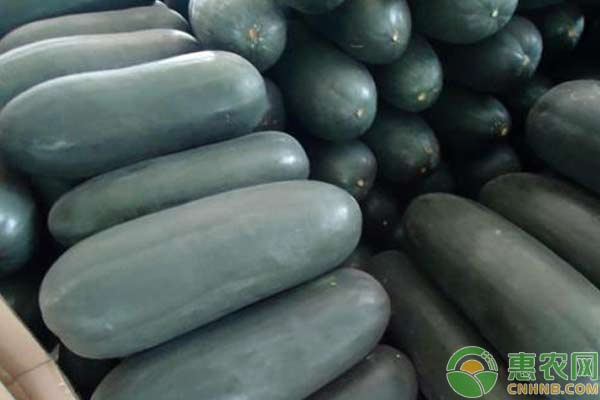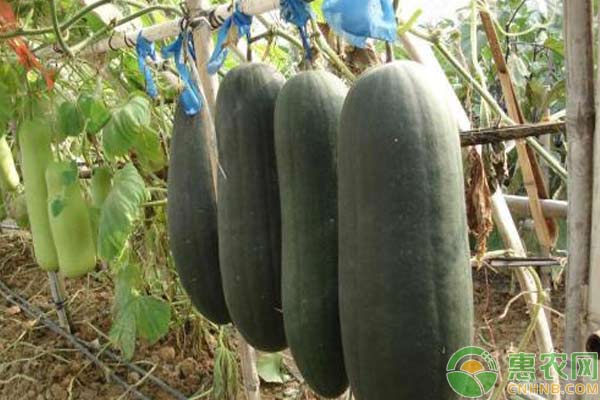Winter melon has the effects of diuretic swelling, weight loss, heat elimination and summer heat, and is deeply favored by consumers. In recent years, with the development of the food processing industry, the economic benefits of winter melon cultivation are also constantly improving, and it has a good planting value. So how do black-skin melons grow? The following small series will introduce the planting process of black skin melon as follows. First, the selection Choose seeds that are resistant to disease, high yield, and good commodity. For example, the Guangdong Academy of Agricultural Sciences has a single shot, Tianxin 999 and so on. Seeds were sterilized with 50% carbendazim 250 times solution for 20 minutes before sowing. Second, sowing seedlings The melon seedlings in our city are concentrated around January, and Sijiu Town is relatively early. The temperature is low, the cold wave is frequent, and early seeding should be carried out by plastic film arch shed. The melon seedlings can be transplanted when they grow 2-3 true leaves and the seedling age is 20-25 days. Third, site preparation Winter melon spring planting, the growing season is in the rainy season, and the melon is extremely intolerant. When the continuous rainwater and the field water are serious, the melon has low resistance and is easy to be infected. In severe cases, it will rotten roots and dead seedlings. Therefore, the spring planting melon should choose high-lying, easy-to-drain, sandy loam or clay loam, which is cultivated from sorghum. 1. Soil disinfection: The soil is disinfected with carbendazim and thiophanate (1.5kg per acre), which can effectively prevent winter melon wilt (soil transmission). 2. Film mulching: Provide superior environmental conditions such as temperature, light, water, fertilizer and soil, promote the growth of winter melon roots and plants, reduce pests and diseases, cold, drought, heavy rain, etc., and increase production by 30%-50%. . The mulch has white, black and silver grey. The white film has a good warming effect, but the weeds are easy to grow. Before spraying, a pre-emergence herbicide such as butachlor and acetochlor should be sprayed. Black film warming effect is slightly worse, but it can prevent weed growth. Silver-gray membranes can repel aphids and reduce the occurrence and spread of viral diseases. 3. Colonization: single row, plant spacing 0.8-1 meters. Fourth, fertilizer management 1. Sowing period: mainly organic fertilizer, supplemented by chemical fertilizer; base fertilizer, supplemented by topdressing. The base fertilizer is applied 300-500 kg of commercial organic fertilizer or 80-100 kg of high-quality ternary compound fertilizer per mu. 2. Seedling stage: The seedling stage is mainly high N fertilizer, but the ratio of N, P, K can not be too unbalanced (like 25-7-8, 18-5-6, etc. N: K ≥ 3 or more), otherwise it will Leading to the melon seedlings, and causing dead seedlings. 24-15 kg, such as 24-6-2, 21-6-13, etc., can increase the spreading of vines, which is conducive to the formation of female flowers and sitting on melons. 3. Stretching vines: When the melons are stretched, the water needs to be large, keep the soil moist, and pay attention to drainage in rainy days. The vine-grown fertilizer gradually turns from high-N fertilizer to balanced fertilizer and increases K content. 15-15-15, 16-16-16, 17-8-15 and other compound fertilizers. After the first female flower is opened, the fertilizer is controlled to control the water, preventing the length of the child. Spraying fungicides can prevent melon disease. Jiatuo water + Shigao or Plex or carbendazim or metalaxyl. 4. Flowering and meloning period: After melon flowering and melon, the main content is high K fertilizer, but the content of N can not be too low (like the ratio of 11-6-23 fertilizer, N content is less than 15, which is not conducive to winter melon The growth of the relatively high K fertilizer has 16-9-20, 16-9-21, 17-8-21 and so on. Fertilization in this period, before the light and heavy, the weight of the melon is about 4 kg, the mu is 40 kg of high-K compound fertilizer, and the potassium fertilizer can be sprayed on the foliar surface, because the potassium is the largest in the expansion period of the melon. Generally, no watering or less watering is required during the flowering period. The water requirement of the melon and fruit expansion period is the largest, and the soil should be kept moist to ensure the yield. Pay attention to drainage in rainy days to prevent water accumulation. 10 days before collecting the melon, the water should be controlled to facilitate storage. This period of sterilization and insecticide prevention is also a key. Five, the whole vine 1. Scaffolding: Use the skeleton dragon root method, use 2 or 3 bamboos to form a skeleton, and cross a bamboo pole as a dragon root. When the melon grows 3-4 kg, use a rope to cover the melon handle and tie it to the dragon root. 2. Picking vines: Winter melons are generally the main vines. Therefore, in order to concentrate nutrients and supply the vegetative growth of the main vines, it is necessary to remove the side vines in time, which is conducive to ventilation, light transmission, pollination and reduction of disease occurrence. Remove all side vines in front of the melon. After the juvenile is selected, the female flower that grows again should be removed. After leaving the melon, the vines are stretched to 10 knots and then the top is removed to concentrate the nutrients. 3. Pressure vine: The melon stems are thick and strong, and the melon period is long. According to the characteristics of the adventitious roots in the melon stem section, it is necessary to pay attention to the pressure vine. It can reduce the burden of scaffolding, prevent the typhoon from blowing down the shed, enhance the ability of the adventitious root to absorb water and absorb water, expand the absorption area, and prolong the life of the vine. Method: Select a sunny day, circle each of the melon vines in the planting distance, press the vines every 3-4 times, and press 3-4 vines. When the vines are pressed, most of the leaves and petioles should be exposed. 4. Leading vines: When the melon grows 16-18 knots, the vines are put on the shelves. When the vines are introduced, according to the direction of the rafts, the vines are turned around the brackets counterclockwise, and there are plans to lead the vines to the west, using their own The melon leaves cover the fruit to reduce sun exposure and avoid burning the winter melon. Sixth, harvest storage 1. Harvest: Winter melon from flowering to flowering for about 9 days, flowering for two days, thanking flower for one day, from flowering to maturity for about 40 days (35-45 days), small melon in the tender fruit to eat mature period, can be taken at any time Received. The large melon is harvested more than when it is mature. The mature feature is that after the fruit stops growing, the fruit hair falls off and the fruit surface appears white powder. Take a small section of the stem and cut it with a leaf and collect it in a cool place for ready supply. 2. Storage: Winter melon is suitable for storage. Storage of winter melon is a good way to solve the supply in the off-season and increase the variety of market colors. For melons stored for storage, it is necessary to select physiologically mature fruits. Large melons should be harvested for more than 40 days. It is ideal for storage. For the storage of melons, the second and third live vines must be selected. Any melons that are bruised, sunburned, rotten, dead vines, and melons that are too tender are not suitable for storage. A few days before storage, the melons stop watering, so that the moisture content of the melons is reduced. The melons for storage need to be harvested at around 8:00 am to avoid sunburn, because the hot hot melons are perishable when stored. In the whole process of harvesting and storage, it is necessary to be light, light, light, and lightly piled. Try to avoid bumping or shocking the melon. Doing the above points can improve the storage stability of melon. The above is the planting process of black skin melon. I think everyone knows about the cultivation of black skin melon. Black skin melon likes a warm environment, is not cold-tolerant, has a suitable temperature of 25 to 30 ° C, and a temperature of 30 ° C. The planting process requires special attention. Ventilation is one of the most important components in a successful greenhouse. Greenhouse Circulation Fan,Greenhouse Ventilation Fan,Automated Greenhouse Ventilation Fan JIANGSU SKYPLAN GREENHOUSE TECHNOLOGY CO.,LTD , https://www.spgreenhouse.com


If there is no proper ventilation, greenhouses and their growing plants can become prone to problems. The main purposes of ventilation are to regulate the temperature and humidity to the optimal level, and to ensure movement of air and thus prevent build-up of plant pathogens (such as Botrytis cinerea) that prefer still air conditions. Ventilation also ensures a supply of fresh air for photosynthesis and plant respiration, and may enable important pollinators to access the greenhouse crop.
How to grow black melon? Black skin melon planting process detailed